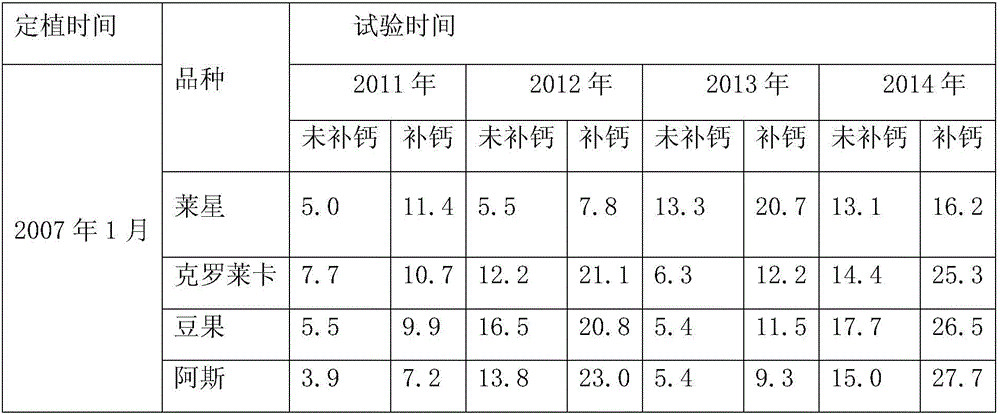Cultivating method of olive trees
A cultivation method and olive tree technology, applied in the directions of cultivation, inorganic fertilizers, calcareous fertilizers, etc., can solve the problems of affecting the quantity and quality of olives bearing fruit, reducing the economic benefits of planting olives, and high requirements for olive planting conditions, so as to improve social benefits and Economic benefits, reducing the occurrence and harm of pests, and good results
- Summary
- Abstract
- Description
- Claims
- Application Information
AI Technical Summary
Problems solved by technology
Method used
Image
Examples
Embodiment 1
[0038] A comparison experiment of tree yield after cultivation without calcium supplementation and the technical solution of the present invention.
[0039] Cultivated tree of the present invention: calcium supplement tree for short
[0040] The tree experiment in the second year after planting was selected, and the unified planting time was January 12, 2010. The same watering, fertilization, weeding and other management and protection measures. The tested varieties were Lessing, Krolaika, Douguo, and Asi. 20 plants of each variety were randomly selected, among which 10 plants were not supplemented with calcium and 10 plants were supplemented with calcium for comparative test. As a result, calcium supplementation increased production by more than 15% compared with non-supplementation for 4 consecutive years from 2011 to 2014. The specific test results are shown in Table 1 below
[0041] Table 1: The impact of calcium supplementation on the yield of olive trees in cultivati...
Embodiment 2
[0044] The tree without calcium supplementation in the cultivation is compared with the damage occurrence degree of the tree disease and pest cultivated by the technical scheme of the present invention.
[0045] The tree experiment in the second year after planting was selected, and the unified planting time was March 12, 2009. The same watering, fertilization, weeding and other management and protection measures. The tested varieties were Kalin, White Olive, Corati and Ezhi. 20 plants of each variety were randomly selected, among which 10 plants were not supplemented with calcium and 10 plants were supplemented with calcium for comparative test. The result was that the calcium-supplemented trees had less damage from diseases and insect pests than the non-calcium-supplemented trees for four consecutive years from 2010 to 2013. The main diseases of olives include: pea freckle, soot, anthracnose and so on. The main pests of olive oil include: scarabs, scale insects, core borers...
Embodiment 3
[0052] In the cultivation, the number of yellow leaves or dead tips of trees without calcium supplementation is compared with that of trees cultivated in the technical scheme of the present invention.
[0053] The tree experiment in the second year after planting was selected, and the unified planting time was January 7, 2009. The same watering, fertilization, weeding and other management and protection measures. The tested varieties were Miza, Kalin, Lessing and Ezhi. 20 plants of each variety were randomly selected, among which 10 plants were not supplemented with calcium and 10 plants were supplemented with calcium for comparative test. The result is the number of yellow leaves and dead branches of calcium-supplemented trees compared with non-calcium-supplemented trees for 4 consecutive years from 2010 to 2013.
[0054] Yellow leaves: Refers to the yellowing of the tender leaves at the top of the olive tree caused by calcium deficiency;
[0055] Dry slightly: refers to t...
PUM
 Login to View More
Login to View More Abstract
Description
Claims
Application Information
 Login to View More
Login to View More - R&D
- Intellectual Property
- Life Sciences
- Materials
- Tech Scout
- Unparalleled Data Quality
- Higher Quality Content
- 60% Fewer Hallucinations
Browse by: Latest US Patents, China's latest patents, Technical Efficacy Thesaurus, Application Domain, Technology Topic, Popular Technical Reports.
© 2025 PatSnap. All rights reserved.Legal|Privacy policy|Modern Slavery Act Transparency Statement|Sitemap|About US| Contact US: help@patsnap.com



